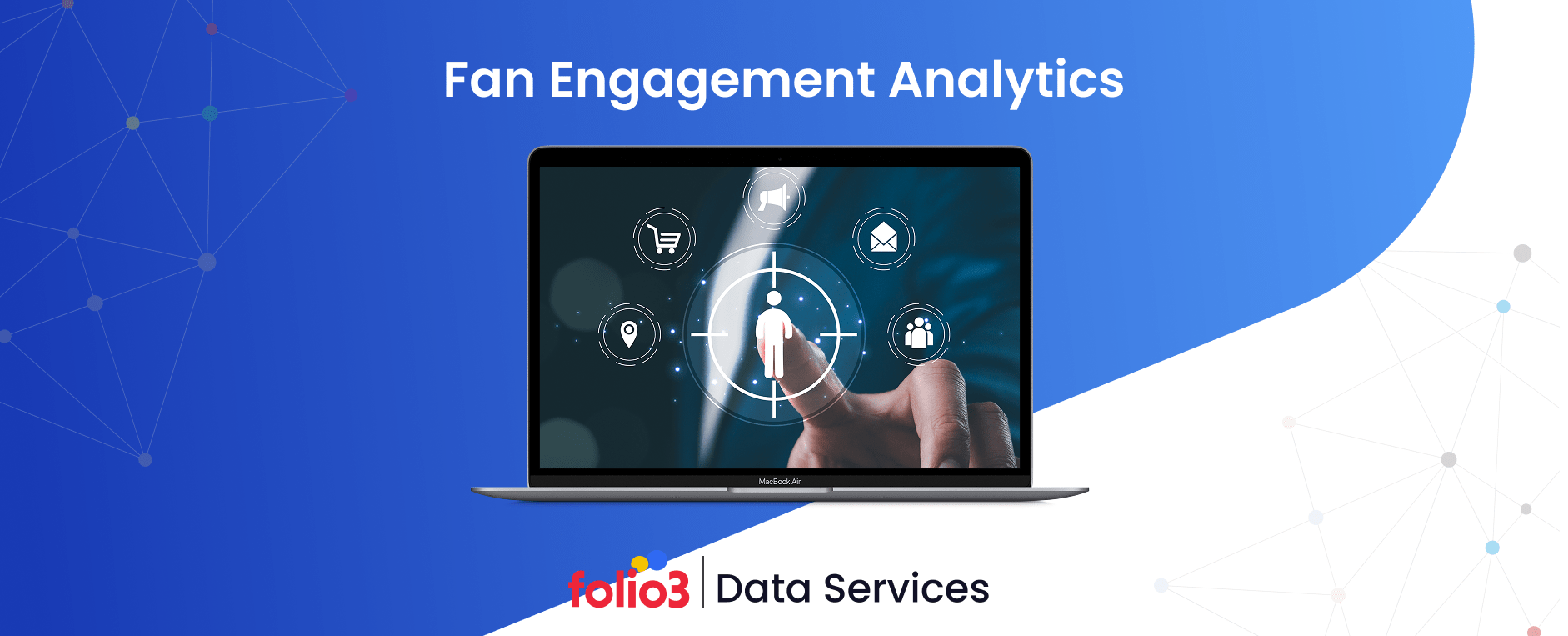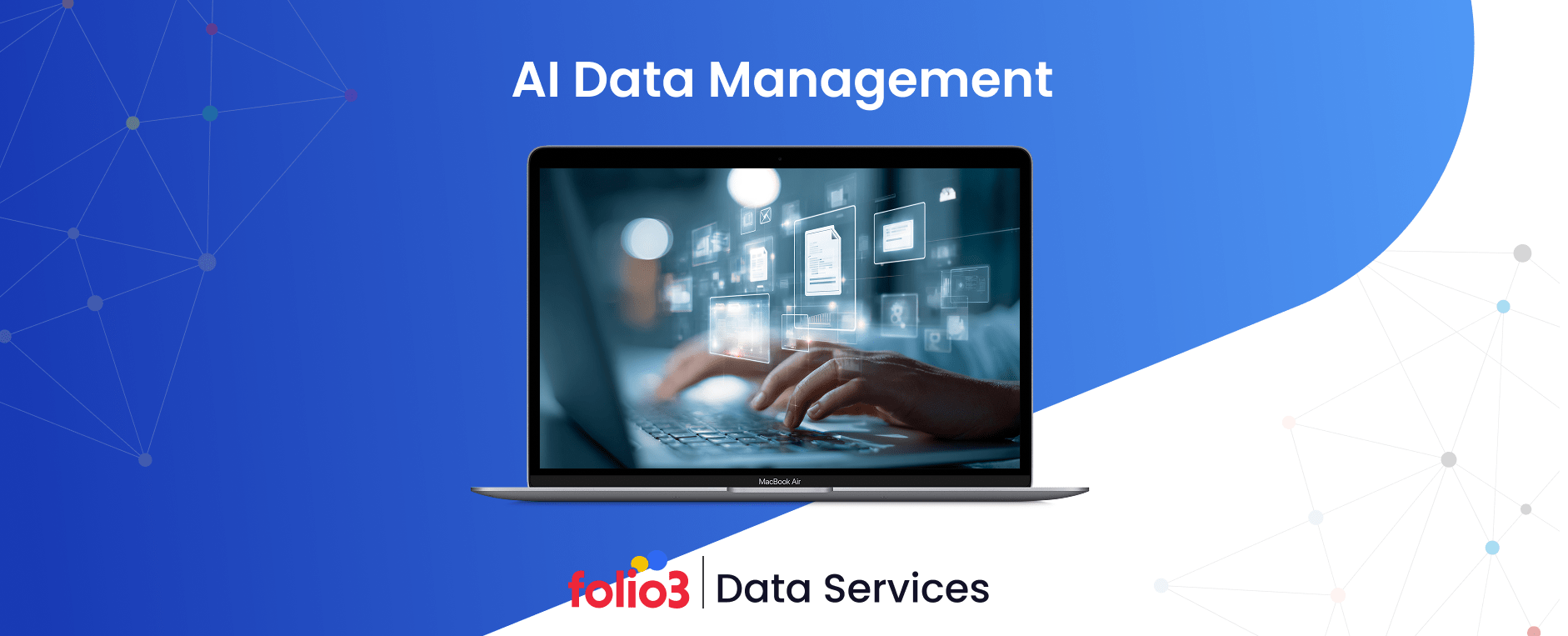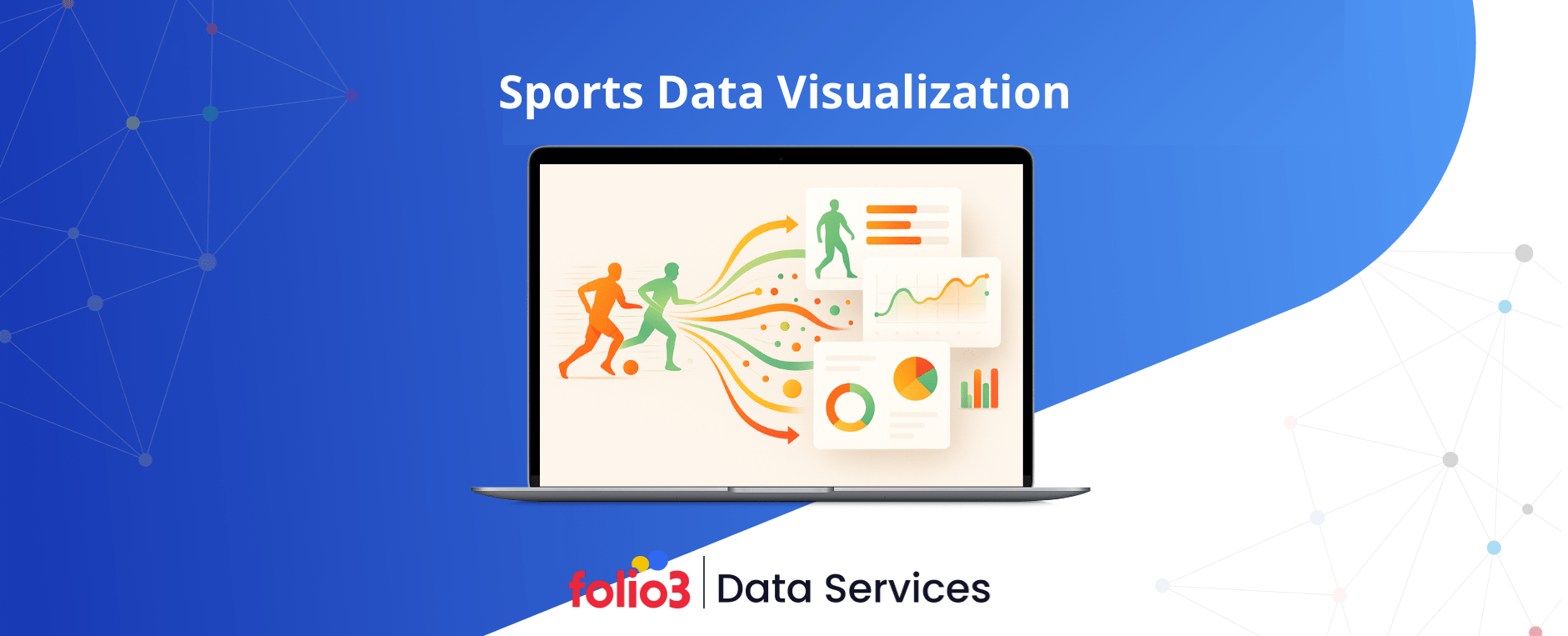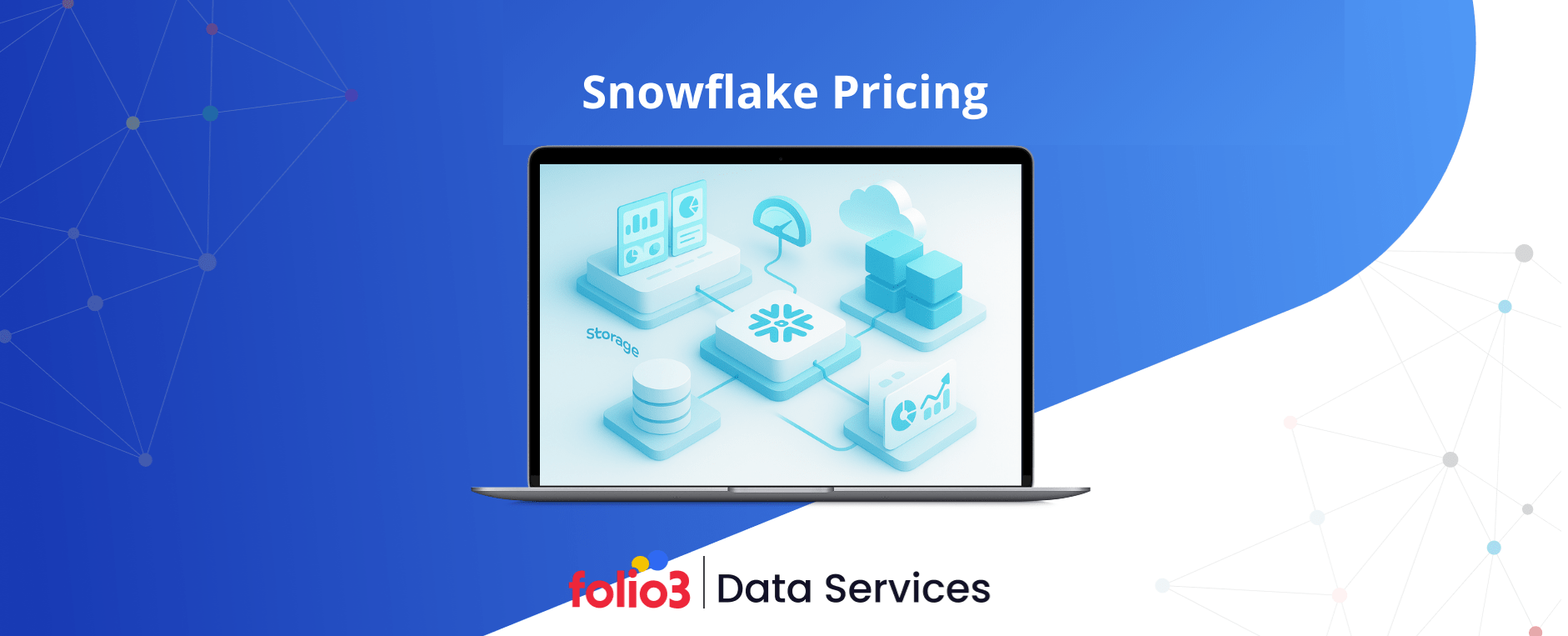The connection between sports organisations and their fans has evolved into a sophisticated, data-driven relationship. Traditional metrics like ticket sales or TV ratings no longer define fan loyalty. Today, fan engagement analytics leverages vast amounts of data from mobile apps, social media, ticketing systems, and streaming platforms to understand not just how fans interact but why.
By combining sports data analytics and fan behaviour analysis, organisations uncover insights that drive stronger engagement, higher retention, and greater revenue. They can identify which content resonates, predict fan churn, and personalise experiences across every touchpoint.
Leading leagues like the NBA and Formula 1 are using these analytics to transform engagement strategies, turning casual viewers into lifelong supporters. This blog explores how fan engagement analytics empowers sports organisations to build deeper emotional connections while achieving measurable business growth.
What is Fan Engagement Analytics?
Fan engagement analytics is the process of collecting, analysing, and applying data to understand how supporters interact with sports organisations across physical and digital channels. It goes beyond attendance tracking to include social media activity, content engagement, purchasing behaviour, and fan sentiment, offering a complete view of audience relationships.
Unlike general marketing analytics, sports fan engagement analytics captures the emotional and communal aspects of fandom, how victories, defeats, and traditions shape loyalty. Using descriptive, diagnostic, and predictive models, organisations can identify engagement trends, understand fan motivations, and forecast future behaviours.
By using fan engagement data analytics, teams personalise communication and experiences at scale. Whether it’s a casual fan following online or a loyal season-ticket holder, analytics helps tailor offers, content, and outreach that strengthen emotional bonds and drive long-term fan value.
How Fan Engagement Analytics Works?
Fan engagement analytics systems combine multiple technologies and processes that turn raw fan data into meaningful, actionable insights. These solutions integrate data sources, analytics models, and visualisation tools that empower sports organisations to make smarter, faster decisions.
Data Sources
Every interaction tells a story. Fan engagement data analytics collects information from ticketing systems, merchandise and concession sales, mobile apps, websites, and social media platforms. Each source provides a unique layer of understanding — from purchase behaviour and attendance trends to content preferences and emotional sentiment. Broadcast data, email campaigns, and customer service records further enrich this unified fan view.
Data Collection and Integration
Integrating data from such diverse sources requires a strong cloud infrastructure. Fan engagement analytics systems use customer data platforms (CDPs) and cloud warehouses to unify fan profiles, eliminate duplicates, and connect activities across devices and channels. Real-time data pipelines enable instant responses such as sending offers after an abandoned cart or alerting staff to sudden drops in engagement.
Analytical Models
Advanced models such as segmentation, churn prediction, and lifetime value forecasting identify patterns and anticipate behaviour. Sentiment analysis interprets emotions behind fan interactions, while recommendation engines personalise content and offers to maximise engagement and satisfaction.
Dashboards and KPI Visualisation
Finally, dashboards transform complex datasets into accessible visuals. Teams track KPIs such as engagement scores, ticket renewals, merchandise sales, and campaign performance. Automated reporting and alerts ensure decision-makers act on fresh insights in keeping engagement strategies agile, targeted, and data-driven.
Top Use Cases & Applications of Fan Engagement Analytics
These applications show that fan engagement analytics isn’t just a marketing tool; it’s a strategic asset that supports smarter operations, stronger relationships, and greater business impact.

Real-Time Stadium Operations
Modern venues leverage fan engagement analytics and athlete monitoring technology to enhance both live experiences and operational efficiency. Systems track crowd flow, concession demand, and queue lengths, while performance data from athletes helps teams correlate fan engagement with on-field performance. Studies show that analytics-enabled stadiums improve fan satisfaction and overall outcomes.
Churn Risk Prediction
By using fan engagement data analytics and exploring the application of predictive analytics in sports, organisations can identify supporters who are becoming disengaged via declining app usage, lower attendance, or negative social sentiment and deploy timely retention campaigns. This proactive approach preserves fan loyalty and maximises revenue potential.
Dynamic Pricing Models
Ticket and merchandise pricing are now driven by sports data analytics that incorporate variables like opponent strength, weather forecasts, and historical demand. Dynamic models, built on a solid data analysis framework, help teams maximise revenue while maintaining accessibility across fan segments.
Personalised Content Delivery
Segmentation and behavioural models enable tailored content for fans, whether it’s video highlights, interactive quizzes, or loyalty rewards. Digital activation strategies, powered by analytics, deepen engagement for both in-venue and remote supporters.
Sponsor Performance Analysis
Brands now expect measurable outcomes from sports partnerships, and fan engagement analytics platforms deliver. Through social media sentiment, exposure monitoring and digital interaction metrics, organisations provide sponsors with transparent ROI and activation insights.
From predictive models to engagement dashboards, Folio3 builds analytics solutions that turn audience insights into action.
Fan Engagement Analytics Tools & Platforms
Multiple technology solutions enable fan engagement analytics, ranging from general-purpose platforms to sports-specific systems such as:
Popular Analytics Tools
- SAS Sports Analytics provides enterprise-grade capabilities, including predictive modelling, customer journey analysis, and marketing optimisation specifically configured for sports applications. The platform handles large-scale data processing and supports sophisticated statistical techniques.
- Tableau offers powerful visualisation capabilities that transform complex datasets into intuitive dashboards. Its drag-and-drop interface makes it accessible to non-technical users while supporting advanced analytics for data scientists. Sports organisations use Tableau to create executive dashboards, operational reports, and detailed campaign analyses.
- KORE Software specializes in sports and entertainment partnerships, providing tools for sponsor activation tracking, hospitality management, and partnership performance measurement. Its industry-specific features address unique requirements that general CRM platforms lack.
- Sports Alliance focuses on membership management and fan engagement for clubs and leagues. The platform combines CRM capabilities with communication tools, event management, and analytics tailored to sports organisations.
- Salesforce Marketing Cloud provides sophisticated marketing automation, journey orchestration, and personalisation capabilities. While not sports-specific, many organisations use it as their foundation for fan relationship management and campaign execution.
Cloud vs On-Premise Systems Comparison
Most sports organizations now favor cloud-based solutions for their flexibility, lower initial costs, and reduced IT burden. On-premise systems remain relevant for organizations with strict data sovereignty requirements or unique integration needs that cloud platforms can’t accommodate.
| Dimension | Cloud-Based Systems | On-Premise Systems |
| Initial Investment | Low upfront costs with subscription pricing | High capital expenditure for servers and software licenses |
| Scalability | Elastic capacity that grows with needs | Fixed capacity requiring hardware purchases to expand |
| Maintenance | Vendor manages updates, security, and infrastructure | Internal IT staff is responsible for all maintenance |
| Accessibility | Access from anywhere with an internet connection | Limited to internal networks unless VPN is configured |
| Customization | Configuration within platform constraints | Full control over customisations and integrations |
| Security Control | Vendor manages security infrastructure | The organisation controls all security measures |
| Deployment Speed | Weeks to implement with minimal IT involvement | Months to deploy with significant IT resources |
| Data Ownership | Data stored on vendor servers with contractual protections | Complete physical control of all data |
| Cost Structure | Predictable ongoing subscriptions | Variable costs for hardware, software, and personnel |
| Disaster Recovery | Built-in redundancy and backup systems | Organisation responsible for backup infrastructure |
Solution Selection Criteria
Choosing the right fan engagement analytics tool requires evaluating several factors. Data compatibility determines whether the platform integrates with existing ticketing, merchandise, and digital systems. Poor integration creates data silos that undermine comprehensive analysis.
Scalability ensures the solution grows with organisational needs. A platform that works for 50,000 fans may struggle at 500,000. Understanding capacity limits and expansion costs prevents expensive migrations when outgrowing initial implementations.
User experience affects adoption across different stakeholders. Marketing teams need intuitive interfaces that don’t require technical expertise. Data scientists need access to raw data and flexible analysis tools. Balancing these different requirements influences platform selection.
Return on investment calculations compare subscription costs, implementation expenses, and ongoing maintenance with quantifiable benefits, such as increased revenue, reduced churn, and improved operational efficiency. Solutions with faster time-to-value generate returns sooner and reduce financial risk.
CRM and Marketing Integration
Fan engagement analytics creates maximum value when integrated with customer relationship management and marketing automation systems. This connection enables closed-loop marketing where analytics insights automatically trigger personalised campaigns and campaign results feed back into analytical models for continuous improvement.
Integration allows segmentation models to immediately inform email targeting, ad audience creation, and content personalisation. Churn prediction alerts trigger automated retention workflows. Engagement scores update based on campaign responses, refining future predictions. This seamless flow between analysis and execution accelerates decision-making and improves results.
How to Implement a Fan Engagement Analytics Strategy?
Implementing a fan engagement analytics strategy involves a structured approach that aligns the correct data, tools, and goals.
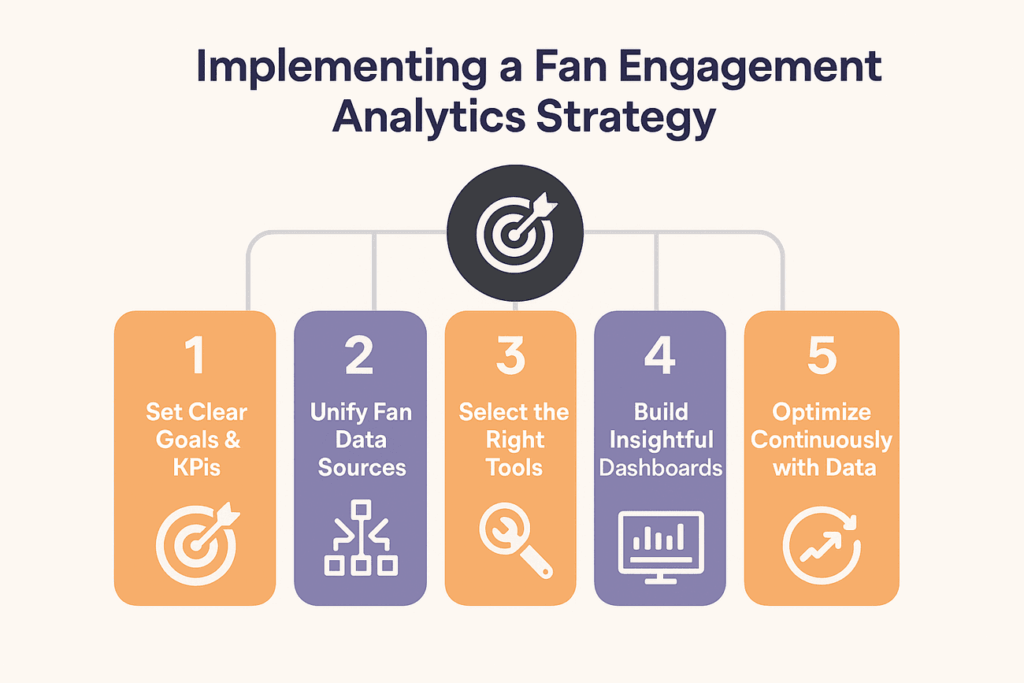
Step 1: Define Objectives and Success Metrics
Set clear, measurable goals such as reducing season-ticket churn by 15% or boosting average revenue per fan by 20%. Tie these targets to business outcomes, such as ticket sales and lifetime fan value.
Step 2: Consolidate Fan Data Sources
Build unified fan profiles by integrating data from ticketing, concession sales, mobile apps, websites, email marketing, and social media. Resolve identities across systems and standardise formats to ensure accuracy.
Step 3: Choose Technology and Analytics Tools
Select platforms that fit your scale and budget. Enterprise tools offer comprehensive analytics suites, while smaller teams can start with targeted solutions. Pilots validate tools and build internal trust.
Step 4: Build Dashboards and Reports
Create dashboards tailored to each team’s role, showing KPIs like engagement scores, conversion rates, and campaign performance. Visualisations make insights accessible, while automated reports keep stakeholders informed.
Step 5: Continuously Optimise Using Insights
Apply sports data analytics via A/B testing and feedback loops to refine your programs. Retrospective evaluation of actions such as retention campaigns shows whether models truly improve fan behaviour.
Fan Engagement Analytics in Different Sports
While fundamental principles remain consistent, fan engagement in sports varies by the unique characteristics of different competitions and audiences.
Football (Soccer) Fan Analytics
In global football, clubs like Manchester City and FC Barcelona lead the way in fan engagement analytics through data-driven personalisation. Manchester City’s Cityzens platform uses behavioural data to tailor digital content and offers, boosting engagement by 40%. Similarly, Barcelona’s fan data ecosystem integrates match attendance, social media activity, and e-commerce insights to improve digital experiences and loyalty programs.
Basketball and NBA Fan Engagement Trends
The NBA leverages advanced sports data analytics to enhance fan interaction. Through the NBA App and League Pass, the league personalises highlights, merchandise promotions, and interactive features based on user behaviour. The NBA’s fan data strategy has driven record-breaking digital engagement and a 30% increase in app interactions.
Esports Fan Analytics
Esports organisations rely heavily on fan engagement analytics to track real-time interactions during live streams, social chatter, and in-game behaviour. Platforms like Twitch and YouTube Gaming use predictive analytics to recommend personalised content, enhancing viewer retention and engagement.
Formula 1 and Motorsport Engagement Data
Formula 1 uses fan engagement data to deliver immersive experiences through its F1 TV platform, mobile app, and social media. Data analytics help tailor content for different regions, boosting global digital viewership by 25%.
Proven Methods to Improve Sports Fan Engagement Analytics
To maximise the impact of sports fan engagement analytics, organisations must go beyond technology adoption and focus on strategic execution that enhances decision-making, personalisation, and long-term loyalty.
As big data in sports industry continues to evolve, these methods help teams translate massive datasets into meaningful, actionable insights.
1. Build a Unified Data Lakehouse
Creating a data lakehouse architecture combines the scalability of data lakes with the structure of data warehouses, providing a single source of truth for fan data.
This integration eliminates silos between ticketing, merchandise, social media, and app interactions, giving analysts access to complete fan profiles for deeper insights and targeted engagement.
2. Prioritise Real-Time Insights
Real-time fan analytics empower teams to respond instantly to behaviours, whether it’s recovering abandoned purchases, tailoring in-game experiences, or adjusting stadium operations. With streaming analytics tools like AWS Kinesis or Databricks, organisations can process massive data flows within seconds, ensuring every fan interaction adds measurable value.
3. Implement Strong Data Governance
Effective data governance safeguards fan privacy while enabling analytical precision. Establishing clear policies for data collection, consent, retention, and use ensures compliance with regulations such as GDPR and CCPA. Maintaining transparency strengthens fan trust and supports sustainable engagement strategies.
4. Foster a Data-Driven Culture
Technology alone isn’t enough because teams must embrace data-driven decision-making. Leadership should champion the adoption of analytics, use data in strategy discussions, and train teams to interpret insights responsibly. This cultural shift promotes consistency and accountability.
5. Start with Pilot Programs
Launching pilot analytics programs allows organisations to test tools, validate outcomes, and demonstrate ROI before scaling. Starting small helps refine integration processes, reduce risk, and secure internal buy-in for broader transformation initiatives.
Key Challenges and Best Practices in Fan Engagement Analytics
While fan engagement analytics offers immense potential, organisations often face challenges that hinder data-driven transformation if not managed strategically.
1. Data Silos and Integration Issues
Disconnected systems such as ticketing, e-commerce, apps, and social media create data silos that obscure the entire fan journey. Integrating these sources into a unified fan profile requires robust infrastructure, identity resolution, and real-time synchronisation.
Partnering with data integration consultants can help organisations design scalable architectures and overcome these hurdles to deliver seamless, personalised fan experiences.
2. Privacy and Consent Management
With regulations such as GDPR and CCPA, managing data privacy has become a top priority. Organisations must secure informed consent, allow data access and deletion, and maintain transparent governance frameworks. Balancing compliance with analytical insights ensures fan trust and long-term engagement.
3. Data Quality and Accuracy
Poor data quality from incomplete records to duplicate entries can derail analytics initiatives. Implementing regular validation, cleansing, and enrichment processes helps maintain accurate fan data and ensures reliable predictions that guide meaningful action.
4. Best Practices for Actionable Insights
To turn analytics into impact, insights must be accessible, relevant, and easy to act on. Embedding analytics into existing decision-making workflows and presenting insights in clear, business-friendly formats ensures adoption and maximises the value of fan engagement analytics.
How to Choose the Right Fan Engagement Analytics Solution?
Selecting the right fan engagement analytics solution is a critical step toward maximising fan engagement and driving business growth. To ensure long-term success, organisations must evaluate tools based on data compatibility, scalability, user experience, and return on investment (ROI) rather than flashy features.
Evaluate Data Compatibility and Integration
The ideal platform should integrate seamlessly with existing systems such as ticketing, merchandise, CRM, and marketing tools to eliminate data silos and enable unified fan insights. Strong integration capabilities ensure smooth data flow, reducing manual work and improving decision-making accuracy.
Ensure Scalability and Flexibility
As fan bases grow and analytics demands evolve, scalability becomes vital. The chosen solution should handle increasing data volumes without performance issues. Cloud-based analytics platforms often offer the flexibility and cost efficiency needed for scaling, but organisations should carefully assess factors such as data sovereignty and vendor reliability.
Create a Comparison Checklist
Building a comparison matrix simplifies decision-making. Evaluate platforms based on integration ease, visualisation features, pricing transparency, data security, and vendor support. Prioritising tools that align with organisational goals ensures sustainable results.
Avoid Common Mistakes
Avoid rushing the selection process or underestimating integration complexity. Neglecting user adoption or ignoring the total cost of ownership can lead to expensive re-implementations. A structured, business-driven approach ensures the chosen fan engagement analytics platform delivers measurable value and enhances fan relationships.
How Folio3 Drives Fan Engagement Analytics Success?
At Folio3, we empower sports organisations to transform how they understand and engage their audiences through advanced sports analytics solutions. Our end-to-end approach combines data integration, real-time analytics, and AI-driven insights to help teams make informed, data-backed decisions that elevate fan experiences and drive revenue growth.
We begin by unifying fragmented fan data from multiple sources, ticketing systems, mobile apps, social media, and merchandise platforms into a single, comprehensive view. This 360-degree fan profile enables personalised marketing, predictive engagement strategies, and smarter business operations.
Our custom fan analytics dashboards turn complex data into clear, actionable insights that decision-makers across marketing, sales, and operations can easily interpret.
Folio3’s sports analytics experts specialise in implementing scalable, cloud-based solutions that support real-time monitoring, churn prediction, and sponsorship ROI tracking.
With a strong emphasis on data governance and privacy compliance, we ensure your analytics initiatives meet regulatory standards while building fan trust.
Drive fan engagement, loyalty, and revenue with data solutions designed by Folio3’s sports analytics experts.
Case Studies: Data-Driven Fan Engagement Success
Successful fan engagement analytics initiatives prove how data-driven strategies can strengthen connections and fuel growth across the sports industry.
NBA’s Fan Data Platform
The NBA built a centralised fan data analytics platform that aggregates insights from ticketing, digital, and social media interactions. This system helps teams personalise marketing, optimise promotions, and understand regional preferences. According to Microsoft, the NBA’s partnership with Microsoft Azure enables real-time insights and predictive modelling, driving deeper digital engagement and revenue growth.
Manchester City’s Digital Engagement Strategy
Manchester City leverages fan engagement data analytics to deliver personalised content and offers across its digital channels. Using tools from Qualtrics and SAP, the club tailors experiences based on fan preferences, leading to a 40% increase in engagement and stronger global fan relationships.
Formula 1’s Fan Data Insights
Formula 1 utilised sports fan analytics to revamp its digital ecosystem and attract younger audiences. Through its collaboration with AWS, F1 analyses real-time race data and fan behaviour to deliver immersive content experiences and predictive race insights. This data-driven approach boosted digital engagement and dramatically expanded its global fan base.
Trends Shaping the Future of Fan Engagement Analytics
The future of fan engagement analytics is rapidly evolving with innovations in AI, immersive experiences, and data ethics transforming how sports organisations connect with their audiences.
AI-Driven Fan Personalisation
Artificial intelligence will elevate sports fan engagement analytics by enabling hyper-personalised experiences.
Beyond tailored content, AI will dynamically adapt mobile apps, websites, and campaigns to each fan’s behaviour and preferences, creating millions of unique digital journeys. Advanced AI powered data extraction will also help unify fan information from multiple touchpoints, ensuring personalisation is both accurate and adaptive.
Real-Time Sentiment Tracking
With advancements in real-time analytics, organisations will monitor crowd emotions during live events to instantly adjust in-stadium entertainment, digital messaging, and promotional strategies, turning insights into immediate action.
Predictive Behaviour Analytics
Enhanced predictive modelling will forecast individual fan actions, such as event attendance and merchandise purchases, enabling highly targeted, data-driven engagement that deepens loyalty and boosts conversions.
Virtual & Metaverse Experiences
As sports move into virtual spaces, metaverse analytics will track engagement within digital stadiums, virtual watch parties, and immersive fan zones, helping teams design profitable and interactive fan ecosystems.
Sports Data Privacy Ethics
With increasing data collection capabilities, fans will expect greater transparency and control. Organisations prioritising ethical data governance and consent-driven analytics will build trust and long-term loyalty in this new era of digital fan engagement.
FAQs
What is fan engagement analytics, and why is it important for sports organisations?
Fan engagement analytics involves collecting and analysing data across ticketing, social media, and digital platforms to understand fan behaviour. It’s essential for sports organisations because it enables personalised experiences, stronger fan loyalty, and increased revenue. Data-driven engagement helps teams build deeper emotional connections and gain a competitive edge in today’s fan-centric sports landscape.
How does fan engagement analytics help teams understand their audience better?
Through sports fan analytics, teams uncover behavioural trends, content preferences, and emotional triggers that drive engagement. By using segmentation and sentiment analysis, organisations can tailor campaigns and experiences that truly resonate with their supporters. This data-driven understanding replaces guesswork with actionable insights into fans.
What data is used in fan engagement analytics?
Fan analytics draws data from ticketing systems, mobile apps, websites, social media, and point-of-sale systems. When combined, these data sources provide a 360-degree view of fan interactions, preferences, and spending habits, allowing teams to deliver more personalised experiences across every touchpoint.
How do teams measure fan loyalty using analytics?
Fan loyalty analytics combines behavioural and emotional data such as attendance, spending, and satisfaction scores. Metrics like Net Promoter Score (NPS) and customer lifetime value help identify truly loyal fans who not only engage frequently but also advocate passionately for their teams.
What are the best fan engagement KPIs?
Top fan engagement KPIs include attendance rate, digital engagement score, customer lifetime value, churn rate, and sentiment score. These metrics reveal how deeply fans connect with a team and highlight areas to improve engagement, retention, and revenue generation.
Can small clubs or brands use fan analytics affordably?
Yes. With cloud-based fan engagement analytics tools, even small clubs can analyse fan data without heavy investments. Affordable solutions like Google Analytics or tiered CDP platforms let organisations start small, gain quick wins, and scale their analytics as budgets grow.
How do AI and predictive models improve fan engagement?
AI-powered fan engagement platforms use predictive models to forecast fan behaviour, churn risk, and content preferences. Machine learning identifies trends hidden in massive datasets, enabling real-time personalisation and proactive engagement that boosts satisfaction and loyalty.
How do social media analytics contribute to fan engagement insights?
Social media analytics tracks fan sentiment, engagement levels, and trending topics across platforms. By analysing fan reactions in real time, teams can refine marketing strategies, respond quickly to feedback, and strengthen emotional connections with their online communities.
What tools and technologies are commonly used for fan engagement analytics?
Popular fan analytics tools include Tableau, Power BI, Salesforce, Segment, and Sprinklr, while cloud platforms like AWS and Azure provide scalable infrastructure. These technologies work together to collect, process, and visualise fan data for strategic decision-making.
How can fan sentiment analysis improve marketing and sponsorship decisions?
Fan sentiment analysis uncovers emotional reactions to campaigns, events, and sponsors, helping teams optimise marketing strategies and strengthen partnerships. Positive sentiment drives engagement and brand loyalty, while negative feedback enables quick corrective action to achieve better outcomes.
Conclusion
Fan engagement analytics has become essential for understanding, retaining, and growing loyal audiences. By leveraging real-time insights, predictive models, and AI-driven personalisation, organisations can build stronger connections and drive measurable business results.
Partnering with experts like Folio3 Data Services helps teams experience the full potential of fan data through advanced analytics, integration, and strategy. From unified fan profiles to actionable insights, Folio3 empowers sports organisations to turn data into lasting engagement and growth.
